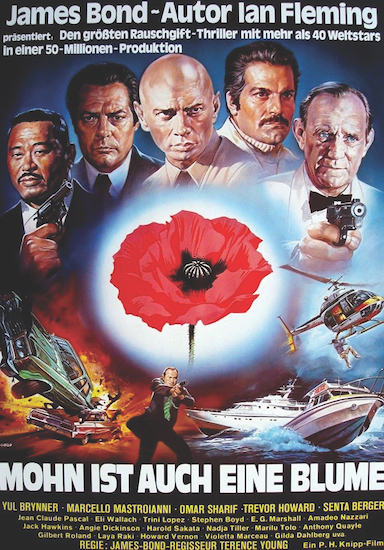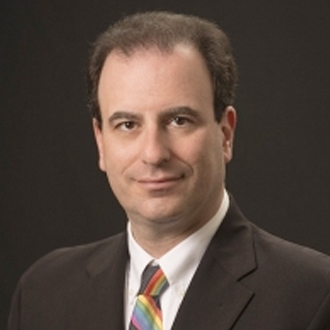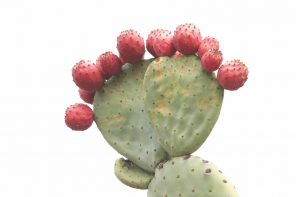In concept, how could the film fail? An international tale rich with intrigue based on a story by the creator of James Bond, shot in exotic locations and featuring an impressive lineup of international film stars: What could go wrong?
Alas, “The Poppy is Also a Flower” (1966) is barely remembered as the last attempt to sell the United Nations’ good works to a skeptical world via narrative film productions. Indeed, the backstory was better than the film.
This story begins in April 1964, when the United Nations Development Fund announced plans to create six 90-minute telefilms highlighting U.N. global initiatives. The world body created a nonprofit called Telsun Foundation to produce the films, and Xerox Corp. provided $4 million in funding. An initial publicity flurry promised the participation of Alfred Hitchcock, Otto Preminger and Stanley Kubrick, but none of these directors would ever become involved.
The first three films in this series — “A Carol for Another Christmas,” “Who Has Seen the Wind?” and “Once Upon a Tractor” — attracted A-list talent on both sides of the camera, but many critics and viewers complained the productions were preachy and too heavy with U.N. propaganda. The Telsun team, headed by Edgar Rosenberg (better known today as Joan Rivers’ husband), decided that more razzmatazz was need to give the series a degree of style that would not make the U.N. aegis feel that obvious.
During this time, the James Bond film franchise was the dominant box office force. Telsun Foundation tapped Terence Young, the director of the first two 007 films, to direct a film, and Young zeroed in on the work of the U.N. Permanent Central Opium Board and Drug Supervisory Body as the source for a great thriller. Young managed to get Ian Fleming, the author of the 007 books, to contribute a story outline to this effort. (Fleming died in August 1964, making this one of his final creative outputs.)
Young told the press that Sean Connery would star in this new film opposite William Holden, Sidney Poitier and Kim Novak. None of them appeared in “The Poppy is Also a Flower,” although an impressive lineup was assembled, including Yul Brynner, Omar Sharif, Marcello Mastroianni, Rita Hayworth, Angie Dickinson, Jack Hawkins, Gilbert Roland, Stephen Boyd and Anthony Quayle. To keep the budget from hemorrhaging, cast members agreed to work for low wages to show their support for the U.N. Some sources claim the actors received one dollar for their work. Young said Eli Wallach was enticed into the film with a free air flight to France and six dress shirts.
The biggest casting coup for the film was Princess Grace of Monaco. The former Grace Kelly retired from the screen in 1956 to marry Prince Rainier, and this would mark her first appearance before the camera in a decade. Her Serene Highness opens the film ruminating on the seemingly benign poppy and how the pretty little flower is the source of the opium imprisoning so many young people in drug addiction. She praises U.N.’s effort in fighting opium trafficking — which, in retrospect, was odd because Monaco had yet to join the world body.
After the pleasant surprise of the former Grace Kelly’s appearance, “The Poppy is Also a Flower” quickly falls into a connect-the-dots story of international intrigue. In the absence of a glamorous James Bond central figure, the film offers two decidedly less-dreamy U.N. drug enforcement agents played by Trevor Howard and E.G. Marshall — fine actors, to be certain, but not really the 007-brand of espionage machismo. The story opens in the Shah’s Iran, where an undercover American agent (Stephen Boyd) is killed after negotiating the sale of opium with a tribal leader (Welsh actor Hugh Griffith, still wearing his “Ben-Hur” greasepaint makeup).
Although Iran was a major source of opium exports, the film depicts the Shah’s government as proactive warriors against this drug traffic — with military and law enforcement officers played by Sharif, Brynner and Hawkins. The dead man’s wife (Dickinson) also turns up in Iran, which is confusing since he was supposedly a bachelor. The Iranians inject a radioactive element into the opium shipment to monitor its travel, and it winds up in Naples where the local police chief (Mastroianni, his English dialogue obviously dubbed) interrogates the drug dealer-turned-aspiring merchant “Happy” Locarno (Wallach), a woman wrestler hooked on Persian dope (Senta Berger), and the freighter captain that transported the radioactive opium (Quayle).
To his credit, director Young downplayed the obvious U.N. marketing that marred the series’ earlier films. The film’s marketing highlighted Ian Fleming and omitted the global organization. However, he went too far in the opposite direction, shooting a 007 film without a two-fisted macho James Bond at its core. And the big-name cast became a burden rather than a benefit, with the A-listers creating a spot-the-star game reminiscent of other 1960s extravaganzas like “How the West Was Won” and “It’s a Mad, Mad, Mad, Mad World.”
Plus, not every star was right for his or her role: The finale on a train to Paris featuring everyman Marshall punching down oversized Harold Sakata (the brutish Oddjob from “Goldfinger”) while Hayworth walked about in a narcotized haze carrying a yapping Poodle was among the craziest climaxes ever filmed.
When “The Poppy Is Also a Flower” was finished, no one quite knew what to do with it. ABC-TV gave it a one-time broadcast in April 1966, marketing the film as “The Poppy is Also a Flower” but inexplicably ran a print with the title “Poppies are Also Flowers.” Strangely, the film was in U.S. theaters one year later, but few people paid for something they already saw on TV.
In other countries, the title was switched to more sellable banners. It was “Danger is Wild” in Great Britain and Australia, “Flowers of the Devil” in Spain” and “Operation Opium” in France and Scandinavia. Ten minutes of footage was added for overseas theatrical screenings, but the Princess Grace opening was deleted when it was put on the big screen. It has turned up on home video and DVD as “The Opium Connection.”
No matter what it was called, it was not welcomed. Film Daily cruelly remarked, “The best that can be said about this picture is that it’s junk but hardly habit-forming.”
The failure of “The Poppy is Also a Flower” ended the U.N.-Telesun film output. The final two films in the six-production series were never made. Today, “The Poppy is Also a Flower” exists in poor 16mm duped prints available on YouTube and cheapo DVD labels, a cruddy shadow of its once-impressive pedigree. The poor poppy has wilted beyond recognition.





